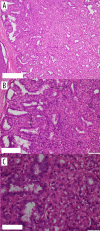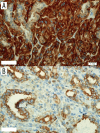Adenomyoepithelioma of the Breast: A Report of 3 Cases
- PMID: 35400730
- PMCID: PMC9011969
- DOI: 10.12659/AJCR.936070
Adenomyoepithelioma of the Breast: A Report of 3 Cases
Abstract
BACKGROUND Breast adenomyoepithelioma is a rare benign breast tumor characterized by a biphasic proliferation of epithelial and myoepithelial cells with variable clinical and diagnostic features. Establishing the diagnosis, determining optimal therapy, and predicting outcome are problematic because of the rarity of this entity. There have been only 2 large series of adenomyoepitheliomas of the breast, reported by Tavassoli and Rosen, which included 27 and 18 patients, respectively. In this report, we present 3 cases of breast adenomyoepithelioma. CASE REPORT Herein, we report 3 cases of breast adenomyoepithelioma. The first case is of a 64-year-old woman who was found to have right breast microcalcification on a screening mammogram. The second case is of a 74-year-old woman who had a right breast mass. These 2 patients were managed by wide local excision. Postoperative microscopic examination revealed adenomyoepithelioma. The third case is of a 49-year-old woman with bilateral saline breast implants who presented with a left breast mass. A core needle biopsy was done and revealed adenomyoepithelioma associated with usual ductal hyperplasia and ductal carcinoma in situ. CONCLUSIONS Breast adenomyoepithelioma is a rare condition that can pose diagnostic challenges due to variable imaging presentations, necessitating percutaneous core biopsy for initial diagnosis. Correct diagnosis is usually possible only on excisional biopsy and confirmed by demonstrating the biphasic nature of the tumor by IHC. Clinical suspicion coupled with utilizing both radiological and histopathological facilities can aid in the accurate diagnosis and management. For the most part, they are considered to be benign, but they can locally recur.
Conflict of interest statement
Figures





Similar articles
-
Malignant Adenomyoepithelioma of the Breast and Associated Epithelial-Myoepithelial Carcinoma; A Rare Case Report.Int J Surg Pathol. 2022 Aug;30(5):569-573. doi: 10.1177/10668969211070164. Epub 2022 Feb 9. Int J Surg Pathol. 2022. PMID: 35138180
-
Adenomyoepithelioma of the breast with unusual confounding diagnostic feature: a case report.J Med Case Rep. 2022 Aug 8;16(1):302. doi: 10.1186/s13256-022-03507-3. J Med Case Rep. 2022. PMID: 35934703 Free PMC article.
-
ADENOMYOEPITHELIOMA WITH CARCINOMA; EPITHELIAL-MYOEPITHELIAL CARCINOMA WITH EARLY PULMONARY METASTASIS.J Ayub Med Coll Abbottabad. 2024 Jul-Sep;36(3):667-669. doi: 10.55519/JAMC-03-13011. J Ayub Med Coll Abbottabad. 2024. PMID: 39623855
-
Adenomyoepithelioma with a human epidermal growth factor receptor 2-fluorescence in situ hybridization-confirmed ductal carcinoma in situ component: A case report and review of the literature.Medicine (Baltimore). 2020 Oct 16;99(42):e22665. doi: 10.1097/MD.0000000000022665. Medicine (Baltimore). 2020. PMID: 33080708 Free PMC article. Review.
-
Adenomyoepithelioma of the breast: case report and literature review.G Chir. 2018 Jul-Aug;39(4):255-257. G Chir. 2018. PMID: 30039795 Review.
Cited by
-
A rare case of a recurrent atypical adenomyoepithelial tumor of the breast: Case report.Int J Surg Case Rep. 2023 Aug;109:108632. doi: 10.1016/j.ijscr.2023.108632. Epub 2023 Aug 6. Int J Surg Case Rep. 2023. PMID: 37557038 Free PMC article.
-
Concurrence of Adenomyoepithelioma of the Breast and Gastrointestinal Stromal Tumor of the Stomach: A Case Report and Review of the Literature.Med Sci (Basel). 2023 Sep 10;11(3):57. doi: 10.3390/medsci11030057. Med Sci (Basel). 2023. PMID: 37755162 Free PMC article.
-
Adenomyoepithelioma of the breast: a challenging diagnosis on biopsy-case report and literature review.J Surg Case Rep. 2025 Jun 12;2025(6):rjaf372. doi: 10.1093/jscr/rjaf372. eCollection 2025 Jun. J Surg Case Rep. 2025. PMID: 40510396 Free PMC article.
-
Adenomyoepithelioma of the Breast in the Setting of Prior Contralateral Breast Malignancy.Cureus. 2023 May 18;15(5):e39189. doi: 10.7759/cureus.39189. eCollection 2023 May. Cureus. 2023. PMID: 37332453 Free PMC article.
References
-
- Tavassoli FA. Myoepithelial lesions of the breast: Myoepitheliosis, adenomyoepithelioma, and myoepithelial carcinoma. Am J Surg Pathol. 1991;15(6):554–6. - PubMed
-
- Rosen PP. Adenomyoepithelioma of the breast. Hum Pathol. 1987;18(12):1232–37. - PubMed
-
- Hamperl H. The myothelia (myoepithelial cells). Normal state; regressive changes; hyperplasia; tumors. Curr Top Pathol. 1970;53:161–220. - PubMed
Publication types
MeSH terms
LinkOut - more resources
Full Text Sources
Medical

